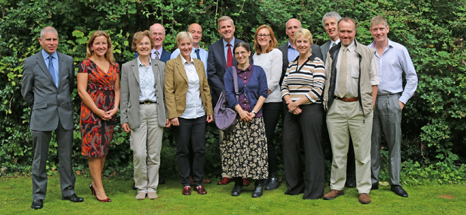 James Cross was welcomed by partner organisations on his first visit to the New Forest National Park.
James Cross was welcomed by partner organisations on his first visit to the New Forest National Park.
He met a number of local stakeholders to discuss working together to protect the area’s landscapes, species and habitat as part of a £19 million conservation agreement – the biggest in Europe.
James revealed that Natural England – which protects the nation’s natural environment – is recruiting 11 new staff members to help with conservation work across Dorset, the Isle of Wight and Hampshire, including the New Forest.
James Cross said: ‘At the heart of Natural England’s new approach is a focus on real world outcomes, delivered in partnership with all of those that have an interest and it’s been really pleasing to see this morning just how well we are working together on the ground.’
Alison Barnes, chief executive of the New Forest National Park Authority, said: ‘We were all delighted to welcome James on his first visit to the New Forest. It was a very productive meeting and wonderful to see his interest in local matters.’
Partner organisations at the visit included the Forestry Commission, Hampshire County Council, Dorset County Council, New Forest National Park Authority, Environment Agency, Verderers of the New Forest, Hampshire and Isle of Wight Wildlife Trust, Dorset Wildlife Trust and the Southern Inshore Fisheries and Conservation Authority.
The New Forest is part of a 10-year Higher Level Stewardship (HLS) agreement between the Verderers of the New Forest and Natural England which will help to safeguard traditional grazing methods, support commoning and restore important wildlife habitat. When the Verderers’ HLS was signed in 2010 it was the largest agri-environment agreement by area in Europe, covering 20,000 hectares, all of which is protected as a Site of Special Scientific Interest.
Diana Westerhoff (Natural England’s appointed Verderer) said: ‘We were very pleased to meet with James Cross and explain to him how the Verderer’s Grazing Scheme works within the HLS. He met with our Head Agister and our Grazing Scheme Administrator and was very impressed by the way the HLS is managed in such a unique place as The New Forest.’
During James’ trip he met the Verderers in the Verderers’ Court in Queens House, Lyndhurst.
He also visited Fletchers Thorns where a river, which had been deepened and straightened in the past, has recently been restored to its natural meandering position within the floodplain. He also heard about how Natural England advisers have worked with the many partners and interest groups within the New Forest to manage 29,000 hectares of unique habitats and rare species including Dartford warblers, nightjars, many species of bats and the rare smooth snake, not to mention the famous New Forest ponies.
The Wetland Restoration Programme is one of the main focuses of the Verderers of the New Forest’s HLS agreement. The programme aims to restore natural processes to around 4,000 hectares of wetland habitats which are degraded and declining due to previous drainage measures. By filling in drainage ditches in mires and wet heathland and reconnecting watercourses with the floodplain these once degraded wetland habitats will be able to sustain the extraordinary wealth of species for which the New Forest is considered so special, for future generations to enjoy. It also provides additional benefits, including:
- reducing the material washed downstream through erosional forces
- reducing the flood risk to communities from flash flood events, as the flow is slowed and flood water retained in the floodplain
- restoring forest landscapes such as streamside ‘lawns’ which become lost to scrub as they become drier due to drainage
- revitalising floodplain fertility which is an important benefit to the commoners of the New Forest whose animals are the ‘architects of the Forest’
James Cross added: ‘This scheme is a great example of how Natural England advisers work within the New Forest to understand the often complex and varied interests of its stakeholders, helping to harness local passion to conserve the ecological and cultural qualities of this special landscape.’